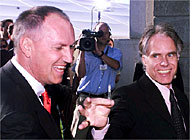Swiss president opens new embassy in Berlin

The Swiss president, Moritz Leuenberger, has opened the new embassy in Berlin with a call for stronger cooperation between the two countries. The run-up to the event was dogged by controversy over revealing photographs of the Swiss ambassador's wife, which appeared in a German magazine.
Opening the embassy on Friday, Leuenberger spoke of Switzerland’s and Germany’s shared goal of preserving peace and security in Europe. He added that the embassy building, located near the new German chancellery and parliament, was a symbol of two countries’ close ties.
Among the guests at the lavish ceremony was Shawne Fielding, the wife of the Swiss ambassador, Thomas Borer. She attended the event in the wake of a row which erupted after revealing photographs of her in and around the embassy appeared in the German magazine “Max”.
The Swiss foreign ministry gave her the go-ahead to attend after she wrote to the foreign minister, Joseph Deiss, apologising for the photographs which depicted her as “a cowgirl of the Alps”.
One photograph showed Fielding in a red costume on the roof of the embassy, with the Swiss flag nearby. In another, she was pictured in a strapless evening dress astride a horse on the embassy steps.
That row has now been resolved but another controversy over the architectural merits of the embassy look set to continue.
The 19th century building survived the Second World War, but many are wondering whether it has been dealt a fatal blow by the architects who renovated it.
Basel architects Diener and Diener supervised the SFr22 million renovation and extension of the embassy, which remained empty for half a century. The concrete cube annex, which was added to the old building, has attracted more than its fair share of criticism.
It represents a complete break in style, retaining none of the visual elements of the palace. Locals have called the cube a bunker or a prison, and the newspaper “Die Welt” described it as an “ugly duckling” and a “step backwards for Switzerland”.
The architects say their decision was based not only on aesthetic considerations, but also took the building’s history into account. The new and the old stand together, they say, as a reminder of the turbulent times the city has gone through and as a witness to the new Germany.
The new embassy has also won plaudits. The Berlin authorities are grateful that the renovated palace still stands along that stretch of the Spree as a reminder of the past.
Most of the surrounding area has been one of Europe’s biggest building sites in recent years. At the end of the Cold War, the no man’s land where East refused to meet West became the continent’s most sought after real estate.
The formerly vacant Potsdamer Platz has become a multi-billion dollar high-tech business district, a reminder of its busy past. And the vast new German chancellery opened last week just next door to the Swiss embassy.
The Swiss authorities had a hard time retaining their valuable real estate, the only building in the neighbourhood to survive World War Two bombing raids. The original plans for the chancellery and the new administrative zone did not include an embassy in their midst.
But the Swiss hung on, despite pressure from the Germans and proposals to move elsewhere. “Trust the Swiss to get a good spot” is a commonly heard sentiment in Berlin these days.
Built in 1871 for the director of the Charité hospital, the embassy has been the property of the Swiss government since the end of the First World War. It was also the scene of what some historians call one of Swiss diplomacy’s darkest hours.
Switzerland’s ambassador to the Third Reich, Hans Fröhlicher, wined and dined Nazi officials within its walls during the war.
Some believe this was to curry favour with the Nazis, others to keep Hitler’s army from invading Switzerland.
The truth lies probably somewhere in between. And like the two dissimilar sections of the embassy, history is somewhere between the extremes.
swissinfo

In compliance with the JTI standards
More: SWI swissinfo.ch certified by the Journalism Trust Initiative
You can find an overview of ongoing debates with our journalists here . Please join us!
If you want to start a conversation about a topic raised in this article or want to report factual errors, email us at english@swissinfo.ch.